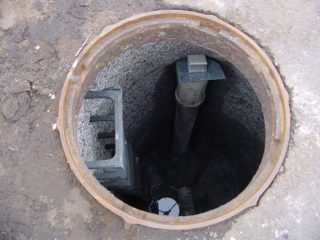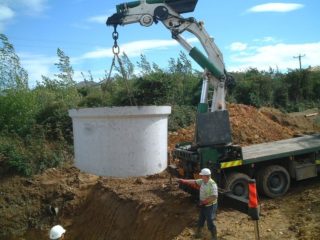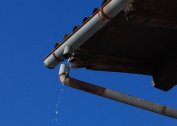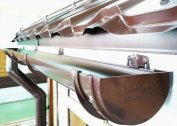A drainage well is necessary to reduce the level of flood waters and drain drains from the infield into a storage tank or into the ground. This protects buildings from damaging effects and prevents waterlogging of the earth. The drainage well can be made of strong concrete rings within one day. The design will last a long time and does not require significant material costs.
Advantages and disadvantages of structures made of reinforced concrete rings
 A well of reinforced concrete rings is by most structural characteristics better than similar products made of bricks or polymers. Reinforced concrete structures have the following advantages:
A well of reinforced concrete rings is by most structural characteristics better than similar products made of bricks or polymers. Reinforced concrete structures have the following advantages:
- The increased durability. The devices are immune to strong horizontal and vertical loads due to seasonal soil mobility.
- The integrity of the design. Sealing is provided by special ledges at the edges of the rings and the use of gaskets. In excessively moving soil layers, fragments of the shaft are connected by welding.
- Immunity to aggressive influences. Concrete is resistant to acid and alkaline components contained in the soil. Also, it is not subject to destruction under the influence of plaque or silt. To spoil reinforced concrete is not within the power of either mice or insects.
- Build speed. With the use of an excavator, the installation of a well will be only half a day.
- Ease of maintenance. The process includes the systematic replacement of the filter and timely cleaning of the walls of the well from deposits.
- Long service life.
The disadvantages include a large mass of rings, which involves the hiring of special vehicles equipped with units for lifting and moving. There is a need for arranging entrances to the installation site.
Varieties of concrete drainage wells
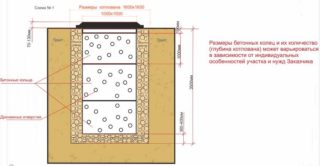 Concrete rings are the most common material for installing drainage systems. They are a great option for arranging a well of any type.
Concrete rings are the most common material for installing drainage systems. They are a great option for arranging a well of any type.
Types of well drainage systems:
- collector (cumulative);
- filtration (absorption);
- inspection (inspection).
The first option is suitable for installation on loamy soils that cannot absorb a significant amount of water. It is used when it is impossible to discharge excess fluid outside the territory. The sealed collector device involves the flow into it of drains from the drainage system with its subsequent use for technical purposes.
On a large territory, two or more installations can be located. When constructing one well, several drainage lines are brought to it. Usually use plastic products with a cross section of 570 mm or more. The speed of filling the tank depends on its volume, and it is collected in the lowest place so that the connected pipes are located above the tank itself.
Absorbers are installed if it is impossible to remove moisture from the site beyond its boundaries or into the city's sewer network. Their design features imply a volume of wastewater not exceeding a cubic meter in 24 hours. The depth of the structure should be more than 2 m. A clinker is poured onto the bottom of the device or a slag, gravel layer of approximately 300 mm thick is created, which contributes to the absorption of moisture. The well top of the well is covered with geotextile material and filled with soil. Most often, filtration wells are installed on sandstones and sandstones. These types of soils absorb moisture well.
Inspection devices are used to identify and remove blockages in highways. Moisture is not collected in them.Installations with a small cross-section (up to 46 cm) are designed for washing pipes. Workers descend into wide wells up to two meters in diameter to carry out manual cleaning. Observation structures are erected at the junctions of pipeline sections or on long straight lines.
A variety of inspection type wells are rotary structures. They are erected at the intersection of pipe segments, at the corners and bends of communication lines.
Preparation for work
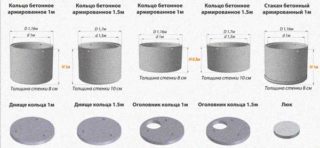 Before constructing a well installation, it is necessary to buy suitable rings made of reinforced concrete with resistance to moisture. Dimensions and cross-section depend on the purpose of the device and the functions of the ring itself.
Before constructing a well installation, it is necessary to buy suitable rings made of reinforced concrete with resistance to moisture. Dimensions and cross-section depend on the purpose of the device and the functions of the ring itself.
Products produce different sizes. Diameter can be from 0.7 to 2.5 m, height - from 0.1 to 2.5 m: the range of options is wide.
For a drainage well, products that are half a meter high and a cross-section of 0.7–1.5 m are usually chosen. Their weight depends on the size and can be from 200 to 900 kg.
Absorption devices are placed on a bulk filter pad. It must be made not less than half a meter high of sand and gravel-crushed stone mixture. Arrangement of a pillow will be required even when the lower reinforced concrete ring is equipped with an integrated filter bottom.
Drives and inspection devices are installed on a bottom slab or on a cement screed. Previously, the bottom of the pit must be tamped. Rings are placed one on top of the other with strict vertical compliance. The joined sections are sealed with bituminous mastic or liquid cement. In order for the prefabricated elements to be fixed securely, they are connected from the inside with metal ties so that one edge of the plate rests on the upper ring, the other on the lower.
Installation Steps
There are two ways to collect a drainage well. If the ring is wide, and time allows, a worker with a shovel gets inside it and digs out the soil from the inside. The concrete part gradually goes into the ground. But this method is time-consuming, and by no means possible for all types of wells. A better construction will turn out if you attract special equipment to create a well pit and install reinforced concrete parts.
How to make a drainage well - instructions for devices from concrete rings:
- They dig a pit of the required diameter and depth so that the rings easily pass into it.
- At the bottom there is a gravel-sand pillow. Its thickness depends on the type of structure.
- Top put the first ring with the bottom. If the latter is not, a cement screed is required.
- Subsequent reinforced concrete parts are installed on top of the previous ones. Joints are sealed.
- After the installation of the upper reinforced concrete element, holes of pipe segments are made in it, if such inputs are not provided for by the design of the ring.
- The ends of the communication elements lead into the holes, the seams are carefully filled with cement or bitumen.
- The gaps between the walls of the pit and reinforced concrete products are covered with sand and gravel.
The upper ring is covered with a cover. It can be made of concrete, but more often use models made of metal or plastic, since they are much lighter.
Well reinforced concrete rings are selected in accordance with the type of soil, climatic features and type of drainage well. The cost of products starts at 700 rubles. The price depends on the dimensions of the concrete ring for the drainage well and the presence of additional design features. Also, the price varies depending on the season, brand of concrete and the manufacturer.
In winter, reinforced concrete rings can be purchased slightly cheaper than in summer, since in the cold, construction of a well is practically impossible. But the prudent owners of private houses take this factor into account and purchase cheaper products for the future.
